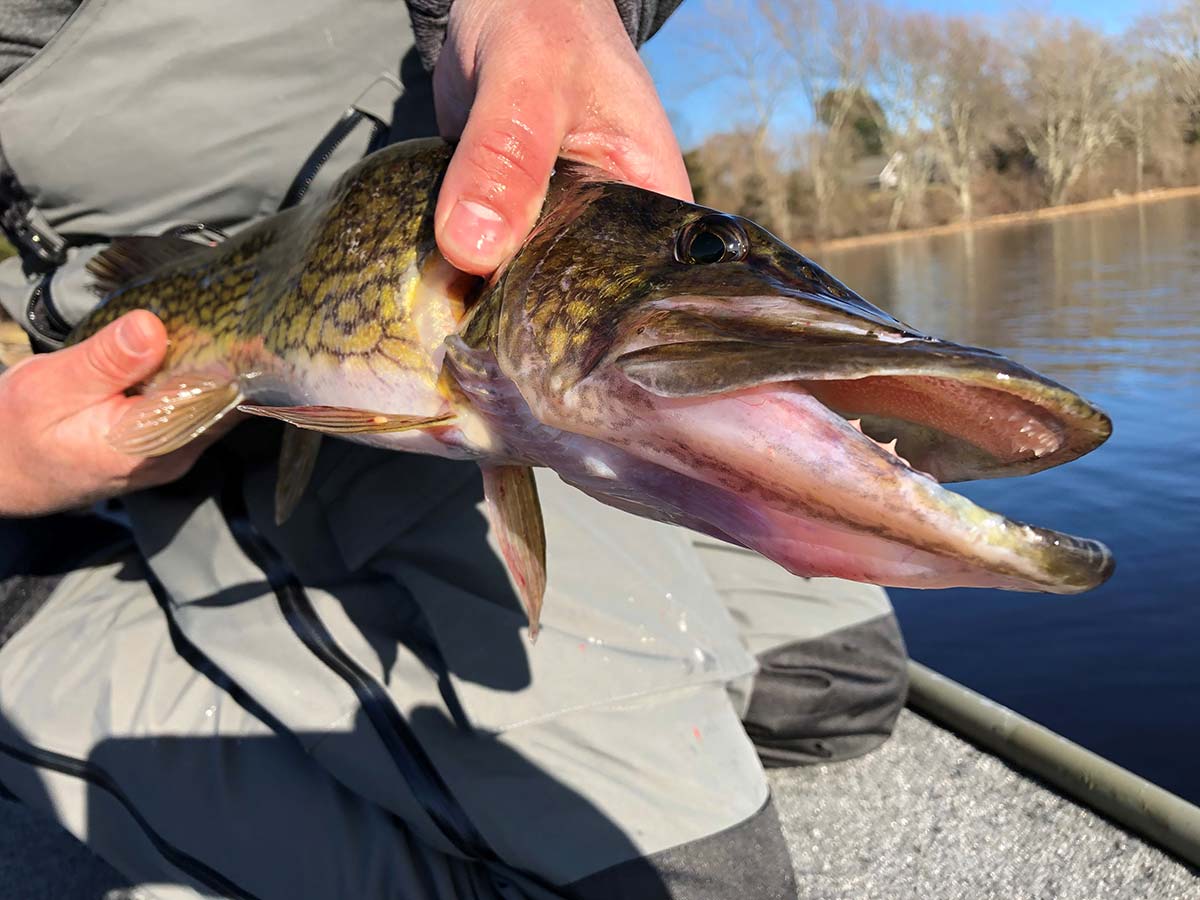
An early last call for open water opportunities before the winter cold sets in.
The chain pickerel – the welterweight of the heavyweights in muskie, tiger muskie and northern pike esocid clan – makes up for its lack of comparable size with availability, aggressiveness and attitude. While muskies and northerns will eyeball a bait time and again while passing by, particularly when November water temperatures are decelerating into the 40s, pickerel will far more often than not make a stab at a last chance victual the moment chance presents itself. A cold and getting colder environ doesn’t seem to deter the kill-and-eat instinct.
Weather does not play much of a role either. If anything, this atmospherically volatile month revs the chainside appetite. With the possible exception of March through mid-April, the November into December span on the calendar provides the best pickerel fishing of the year. One of our most productive days – from bank-side no less – was during a pre-Thanksgiving weekday when wet snow showers intermingled with stinging pellets of freezing rain. The chains were laying in close to the brushy shorelines just off the edges of retreating weeds picking. The livelined shiners didn’t stand a chance.
From this corner, though, it’s the sheer availability of pickerel that makes it such a last minute seasonal draw. From urban and suburban park ponds to acidic, cedar stained pinewoods creeks, to mountain lakes to the upper reaches of tidal rivers with their faint taste of salt, one can encounter the chain pickerel. The common denominator is weeds and, to a lesser extent, submerged structure. Look for milfoil, coontail, lily pads, and the like; if weeds are present, chances are that pickerel will be as well. They’ll stick close by as the weeds retreat and sink, and will also gravitate to areas of sunken brush, timber and stumps. Under and/or alongside docks and boathouse platforms are other late autumn haunts.
This a shallow water predator physically suited to slip and slink through weeds and along breaks. While it will cruise from one spot to another, it is primarily an ambush feeder, taking station where it can intercept roaming baitfish, moving on should that particular location not provide enough prey. As such, November chainsides can be encountered in and around likely holding cover as well as in more open water while on the prowl.
The species’ inherent aggressiveness lends itself well to a variety of presentations. However, for whatever reason, there are those rare occasions when a pickerel will closely inspect an offering before either going in with lightning speed for the kill shot or ignoring it, sometimes backing off in apparent disdain. We’ve witnessed this more than a few times over the many decades, even with live bait, and as simple as it sounds, it is oftentimes a matter of imparting added motion.
A case in point was when the shiner nestled itself in the shallow bottom detritus, the pickerel a mere foot away staring at it. The shiner, realizing it was getting sized up for the slaughter, just sat there. A twitch of the rod tip brought it up from its sanctuary. A swirl, cloud of dirty water and a suddenly tight line. Another similar episode involved a wacky rigged five-inch Z-Man ZinkerZ that brought a nearly 2-foot chain out from beside a laydown for a look see. A twitch, then another, failed to pique the attack mode. A quick upward sweep pulled the trigger.
There’s no denying the effectiveness of a live shiner or similar baitfish when it comes to catching pickerel. Under a float or livelined, it is doomed to a violent demise. But for those who eschew the bait attack, hardware and plastics allow you to cover more water. Suspending and shallow running slim profile plugs will be whipped by late season chains. Although this predator is built for speed and responds to rapid movement, it might take a few casts to figure the retrieve cadence that draws strikes.
Metal matters, this in the form of spinners such as the Nos. 2 Mepps Algia Long (dressed) and Comet Mino. The quarter-ounce and half-ounce Johnson Silver Minnow in firetiger or silver sweetened with 3- or 3-1/2-inch curly tail grub and slow rolled over and around weeds works well. Stick plastics such as the Z-Man ZinkerZ, Mr. Twister Comida and Yamamoto Senkos, more associated with bass fishing, are also surprisingly effective during those rare instances when slow is the way to go.




